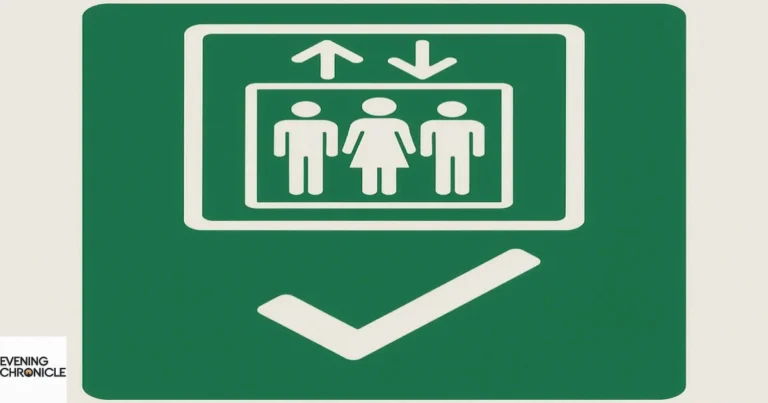Every time you step into a lift (or elevator, as commonly known in the U.S.), you trust that it’s engineered for safety, reliability, and comfort. But there’s one overlooked indicator that quietly does the heavy lifting in keeping you informed: the safety sign inside the lift. Often mounted beside the control panel or near the door, this sign shows when a lift is safe to use—but not everyone takes a moment to understand it.
In this article, we’ll break down the hidden meanings, legal standards, and engineering cues behind this sign, and why every U.S. elevator user should pay attention. You’ll learn what to look for, how to interpret weight limits and inspection dates, and when to think twice before stepping in.
What Does the Lift Safety Sign Really Mean?
The “lift safety sign” isn’t just a label—it’s a regulatory requirement backed by state laws and safety standards, including those from ANSI (American National Standards Institute) and ASME (American Society of Mechanical Engineers).
This sign typically displays:
- Maximum load capacity in pounds and/or kilograms
- Maximum number of occupants
- Inspection certification date (showing when the lift was last officially inspected)
- Name of the certifying agency or technician
- Emergency contact information
It confirms that the elevator has passed all safety checks and is functioning within its load and usage limits.
Also read: Excavator as a Crane: UK Safety Guidelines
Understanding Load Capacity: It’s Not Just About Weight
One of the most critical elements on the sign is the load capacity. For most passenger elevators in the U.S., this ranges from 2,000 to 5,000 pounds, depending on the building type.
Why this matters:
- Going over this limit can trigger emergency brakes or system shutdowns
- Exceeding weight thresholds can strain cables and motors, leading to long-term damage
- Modern lifts are equipped with sensors, but manual awareness is still crucial
It’s also essential to understand that load capacity isn’t only about the weight of people—it includes luggage, medical equipment, strollers, and other carried items.
Inspection Dates: Know When to Step Back
That small inspection sticker or certificate is your first clue to a lift’s current safety status.
Look for:
- The date of the last inspection
- The next due inspection
- The license number of the inspector or company
In cities like New York or Los Angeles, elevators are required by law to undergo annual or bi-annual inspections. If the date has expired, it’s a red flag—report it to building management or avoid using the lift if possible.
This Sign Shows When a Lift Is Safe to Use in an Emergency Too
In emergency scenarios—like a fire, earthquake, or power outage—certain signs inside the lift indicate restricted usage.
These include:
- “In case of fire, use stairs” warnings
- Emergency light indicators
- A firefighter’s service mode notice
- Phone or intercom symbols for trapped passenger communication
Understanding these signs could literally save your life during an emergency. They also remind users that lifts aren’t always the best choice when evacuating a building.
Legal Requirements & Building Code Compliance
U.S. building codes require all commercial and residential elevators to display safety signs that meet local and federal guidelines. These include:
- ADA (Americans with Disabilities Act) compliance for height and font readability
- ASME A17.1/CSA B44 safety codes
- State-specific elevator operation and maintenance regulations
Property owners and facility managers who fail to comply risk legal consequences, potential liability in accidents, and increased insurance premiums.
Knowing that this sign shows when a lift is safe to use helps protect not only your safety but also ensures that the property is held to high standards.
Conclusion: A Small Sign That Makes a Big Difference
Next time you step into a lift, pause for just 5 seconds and check that sign. It’s more than a formality—it’s a reassurance that engineers, safety inspectors, and laws are working behind the scenes to keep you safe.
Whether you’re in a skyscraper in Manhattan or a hospital in San Diego, this sign shows when a lift is safe to use, and understanding its details could make your elevator experience safer and more informed.
FAQs: This Sign Shows When a Lift Is Safe to Use
Q1. What happens if a lift exceeds the weight limit shown on the sign?
The elevator may refuse to operate, trigger alarms, or stop functioning mid-way. In worst-case scenarios, it can damage internal components.
Q2. Who is responsible for updating the safety sign in an elevator?
Typically, the building’s facility manager or the elevator maintenance company ensures it’s updated according to local regulations.
Q3. Is it illegal to use an elevator with an expired inspection date?
In many states, yes. It can result in fines and liability if an accident occurs. Always report expired inspections to management.
Q4. Why does the safety sign use both pounds and kilograms?
To cater to a broad audience and comply with international safety standards. Most U.S. users follow pounds, but global consistency helps too.
Q5. Can lifts operate without safety signs?
No. Operating a lift without proper signage is a code violation and can result in the elevator being shut down by inspectors.


